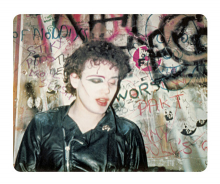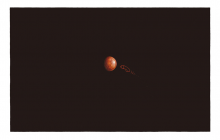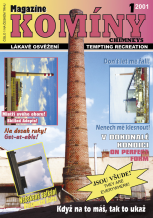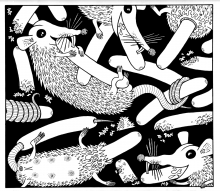| Zeitschrift Umělec 2004/3 >> The Best Known Hacker | Übersicht aller Ausgaben | ||||||||||||
|
|||||||||||||
The Best Known HackerZeitschrift Umělec 2004/301.03.2004 Jiří Ptáček | blasphemy | en cs |
|||||||||||||
|
Again hundredfold
I bestride the swan Sorriness in my eyes Devil in my crotch Everyone passes me by A mile off (...) A Total Goof Blanka Jakubčíková is a spectre. She has had a professional education, so one would imagine that she is aware of what present-day art practice likes most and likes least. It is not for me to judge, maybe she knows it, but I wouldn’t be surprised if she didn’t. It doesn’t surprise me in the ninety percent of the graduates from all art schools, but I always like to follow what consequences it has. Some of the young people cease to work with art right after they celebrate their fresh university degrees. Others try for some years to awaken interest in gallery owners and curators before they become bitter and say that they don’t understand the contemporary requirements of art. Later on they establish ecological farms or go to Afghanistan to build earthquake-resistant polystyrene houses. Some of the more successful individuals, from the 90% majority, manage to jump elegantly into the hellish cauldron of residential programs and workshops and make their suffering a bit longer. The remaining create copies of old art, paint backdrops for Barrandov film studios or help the restorers. Two or three chosen ones get to paint portraits of Russian enterpreneur’s wives while imagining their ascent up the Olympus of videoart or something similarly socially undesirable. This is what (not only) Czech art life reality looks like. I would be happy if Blanka Jakubčíková wouldn’t know that, because her art is obstinate and pestilent, driven by faith that man should be a milk cow of art, and that the seeds of the virus of knowledge reside in collapse and blasphemy. She doesn’t like being a loser, though understood by a theoretician Tomáš Pospiszyl, who selected her for his (long gone) Laboratory in the Czech National fallen angel, and the contemporary general director of the National Gallery, Milan Knížák. But this doesn’t discourage her from making more big drawings, and so she splits the head of Jesus and in the yellow streak writes a slogan: The best known hacker. She struggles with her own hatred against dogma but at the same time, she works with it. She spits on catholicism and feminism and draws jumbles of symbols, whether they already are part of esoteric traditions or not yet. It is interesting to notice that although pluralist society doesn’t refuse opinion variety and contradiction, when the cards are actually revealed, society tends to react with annoyance. This demonstrates an ongoing tension between pluralism and a receding desire to find an all-embracing sense of life and truth? Christ and the emancipational conception of female identity are incessantly subjected to critic discourse. Confronted by the headless hacker or a gigantic penis with that says “Woe me that I put my life into the hands of a woman,” we start asking, “How can Jakubčíková say that? She is a woman and has an obsessive relation to Christianity.” The Cunt is a Temple of Innocence I am in the possession of 300 pages of her poems, and sometimes I like to quote from them. They are very intimate rhymes that changed along with our relationship. It is terminated in total exhaustion, when our correspondence echoed with the unbearable sound of the gnashing of teeth. At the same time her poetry developed. It started as playful heresy and ironically recited anger. It ended in spine-chilling, ritual romanticism—a sister vision of a Czech writer Jiří Karásek from Lvovice and the American writer H.P. Lovecraft. In the middle of murderous sentences Jakubčíková, doesn’t forget to suggest, in good humor, that “God is slightly decadent” and that “Funny are those romantic sighs–they can be quartered by reason.” That was in 2002. Only two years later I, read all the correspondence. And again I felt an unpleasant spine-chilling. The poetry of Blanka Jakubčíková reflects a metaphorical world of her visual work. For example, look at this article’s introductory lines. A female sex organ attacked by the devil. Remember what happened around female genitalia over the last two millenia. And how many times daily it is the subject of even the most public TV programs. A certain “perfection” reached the script writers of the series Sex and the City—they win TV prizes for their sexual conversations. As if there was nothing to add. But there you go—we have Vagina Monologues and Blanka Jakubčíková, in her own way. Her comments on cunts began in 1997, with the Bulimia series. Don’t be mistaken, vomit can come out of places other than the mouth. The labia majora of obese woman can open and utter “I Hate Sigmund Freud” or “I’m So Stupid.” The placard simplicity of such physicality is surprisingly much more concrete than an exposition of genitals in pornographic magazines or the lyricist spirit of the photographs of Jan Saudek. A few years later, Jakubčíková writes “I stink of passion/ head to toe,” and in another verse: The sinkholes are full of scented crap wild females and pubic hairs Vomit, shit and spittle—such excretions are a permanent negative of human cultures. It showed that we are genetically equipped to despise excretions; at least we feel strong contempt for vomit in all cultures, which is a relic of the signal to throw up bad food eaten up by a prehistoric gang. Moreover, we insult one another for thousands of years with crap, fucking and cunts. Blanka Jakubčíková repeats this interconnectedness of excretion and sexuality in new formations. Looking at this from a distance, we can see that she is not inclined to any marginal ethical approaches contented in her unambiguous statements. In one of her verses she speaks about the “Cunt as a temple of innocence,” in another as a victim of psychonanalytical exploitation or about a detestation of a female body whatsoever. The meaning levels of single evocations are sharply limited, but the comparison shows them as a non-homogenous spectrum of attitudes. Jakubčíková respects only the basic essence, which is the body itself. Its character she handles differently. She reflects a world of parallel social conventions which we adopted with their individual elements, roles and meanings and deliberately inverts the implicitely present positives and negatives. I would never change a kingdom for a horse/ only for a camel Blanka Jakubčíková doesn’t represent herself as an enemy of, say, women’s rights of dominance (see assemblage “A woman doesn’t need the right to vote; she has veto power”), her statements only advertise the doctrine of a social convention—a theoretical ideal of women having the same rights as men, and about her not having a submissive nor dominant position in respect to man. Said by a man with the meaning in reverse, it would call for punishment (although we can see and hear this very often), said by a woman artist it is much more ambivalent and personal, designated to capture the viewer by the author’s perspective. Blanka Jakubčíková plays with cultural codes. The verse in which she refuses the Richardian horse opting instead a camel, resembles the ferocious plays of her most transparent cycle, Opus Diabolicum. Devil’s work, from 1999, consists of a lot of large sheets. A godly-satanic mystery on them is presented under an aesthetic pressure of Art Nouveau. But they are also billboards, comics and the Antichrist’s Bible of the poor. Over a zoot-suit dandy in a silk hat, a text polemicizing with the most famous Nietzsche’s line: “God is not dead.” And no doubt, that dandy is Uncle Fester’s handsomer brother. Little Jesus threatens us in a western manner that he is the law, and the Holy Trinity in heaven turns out to be a pack of spies. The religious frame is clear, but at the same time we can see the female role underneath in this inverted mythology. Under the words “God is Love” sits an elegant dominatrix with exposed breasts and cat-o’-nine-tails, Virgin Mary kisses the face of a horned baby Jesus. And Jakubčíková unconditionally respects the counterpoint between text and picture. The text speaks for the Christian, the picture is contradictory. The dualism is based fully on paraphrases and an ironic twist. Similarly simple are the inversions of black metal culture: Darkness is not the opposite of light but a historically conditioned opposite of the Christian idea of light. Therefore, it is still comprehensible in the residual conscience of the Christianity in much more differentiated civilization and it nourishes the nostalgic conception of heresy. Opus Diabolicum presents this simple equation in a placard abbreviation and suggests a new imbalance between what used to be heresy and became a provocation in a crumbled cultural space. It is difficult to find out what Jakubčíková favored. A bit of help is her intention to use painting as a model for a window wall. A new goal is the realization in space, where the relation between Christian faith and its inverted interpretation intensifies. But the pop-cultural canon, which she uses, probably weakens. 3 + 1 = 5 = 8 Motives associated with Christ were of such interest to Jakubčíková that after Opus Diabolicum, she made the cycle Third Sex and another, still unfinished cycle Imitation Christi. The changes of the genitals between man and woman in the first one was requisitioned by a futuristic vision of a human existence, where the profane changes into sacral by way of releasing the body from its historical context. The hermaphrodites at the same time destroy the existing duality of the system suggested in Opus Diabolicum. and so the UFO may become a king and no-one has a chance of survival consequences of this second arrival as it is evidently right we await the second, third coming of the hermaphrodite Christ and alike dioceious pearly lady and it is no illusion that the third sex is actually four herein Jakubčíková’s obsession with numbers and numerological speculations gathered breath for never-ending combinations and the associated communication ability. In the first drawings of Imitatio Christi she neurotically looked for a Rubens shape of a religious figurative composition and highlighted symbolic neologisms. But its meaning and spacial ornamental role is blurred, the mixture of Roman alphabet, runes and some “beetles and electronic circuits” breaks the border between hermetism and automatic drawing. The drawings are extremely interesting; they are rituals of scrambled emotions. It’s... The Toť cycle (It’s) was an unexpected thawing. She began in 2003, after settling in Prague, and she started painting with markers on small sheets; soon she had an extensive diary. Floor plans of visited interiors sit next to dates and pure sign abstractions made of lines, arrows and points. Because Blanka Jakubčíková always quoted from some models, here two manifestations of folklore meet: the ancient beauty of folk paintings and a new moving beauty of street art aesthetics. Omnipresent arrows direct our attention towards the epicenters of composition, which is often a calligraphically written Toť. A concrete identification of the colorful pictures with people and places are again an attempt to catch the inner dynamics of the motifs. They reflect on the “problematics of space, time, non-time, relativity and reality, beginning, middle, end, nothing, nowhere, everything... and this according to a saying: nobody, nothing and ever play techno together,” writes Jakubčíková in a commentary to the show in the Doubner Gallery. Blanka Jakubčíková rhymes again, she folklorizes in her drawings, because this is the only thing that differs her work from certainty. So he creates her distance from the viewer and reader. What she sounded in the beginning of Imitation Christi as a radical challenge to revaluate religious teachings, she again forces to cross the affirmation and faltering. Imitatio Christi has changed too. There are other big drawings, e.g. The best known hacker, Fly in the ointment or Virgin Mary. Initial pathos has passed, replaced by a grotesque eeriness. Fewer symbols and more color connected the drawings. Their toxic colors supported the demonic looks of portraits and transformed them into a psychotropic vision. The narrative frame narrowed. Unfortunately, these drawings got lost while moving house. Imitatio Christi still waits for its termination. Wandering on the border of a visionary lunacy and blasphemous Bacchanalia continues. But as the author says: When we cower at our execution they behead us with a sharpened board for letting blab our jabbering chopped off head quite allowed to tell the gamekeepers wife about action – inaction formation of a secret faction which with an axe or a whacker crowns the alchymist to be a cyber punk hacker who with the help of a divining rod and modern magic formula sealed the poetess of Lesbos on an elephant as in W Gibons Neuroneuroproto chant
01.03.2004
Empfohlene Artikel
|
|||||||||||||
|
04.02.2020 10:17
Letošní 50. ročník Art Basel přilákal celkem 93 000 návštěvníků a sběratelů z 80 zemí světa. 290 prémiových galerií představilo umělecká díla od počátku 20. století až po současnost. Hlavní sektor přehlídky, tradičně v prvním patře výstavního prostoru, představil 232 předních galerií z celého světa nabízející umění nejvyšší kvality. Veletrh ukázal vzestupný trend prodeje prostřednictvím galerií jak soukromým sbírkám, tak i institucím. Kromě hlavního veletrhu stály za návštěvu i ty přidružené: Volta, Liste a Photo Basel, k tomu doprovodné programy a výstavy v místních institucích, které kvalitou daleko přesahují hranice města tj. Kunsthalle Basel, Kunstmuseum, Tinguely muzeum nebo Fondation Beyeler.
|









































 New book by I.M.Jirous in English at our online bookshop.
New book by I.M.Jirous in English at our online bookshop.
Kommentar
Der Artikel ist bisher nicht kommentiert wordenNeuen Kommentar einfügen